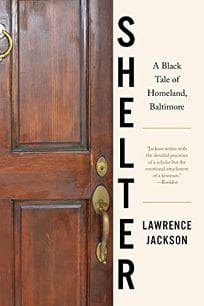
MAY 17, 2022
By Michael A. Fletcher
Baltimore’s hardscrabble Park Heights neighborhood is maybe five miles from stately Homeland, but when it comes to lived reality it is a world away. The same could be said of Brooklyn’s Brownsville and Park Slope, Washington’s Congress Heights and Capitol Hill, and countless other neighborhoods in countless American cities deeply divided by race and class.
Those divisions are a consequence of a shared but unequal history that persists, even for those with the good fortune to “move up” from one world to the other. That theme underlies “Shelter: A Black Tale of Homeland, Baltimore,” the penetrating new book by Johns Hopkins University professor Lawrence Jackson.
“Shelter” is a memoir of Jackson and his hometown. The story is told in wide-ranging essays that touch on subjects including the joys and challenges of Black fatherhood, the overlooked history of his new, mostly White neighborhood of Homeland, his connection to his childhood church, the perils of Black upward mobility, the pain of divorce, and the everyday challenges of homeownership. The book is by turns searing, informative and funny, as Jackson explores both serious issues and absurdities of his life and his city.
Jackson is a historian, biographer and fourth-generation Baltimorean who grew up in nearly all-Black Park Heights, a working-class section of the city that in recent decades has fallen on hard times. After going off to college and graduate school and launching his academic career, he returned to Baltimore in 2016 for a job as a distinguished professor at Hopkins, a university widely regarded as one of the nation’s finest even as it maintains a distant and difficult relationship with Black Baltimore.
When Jackson came back, he chose to buy in Homeland, a beautiful community with stone houses, winding streets, tall trees, and a series of ponds and fountains known as the Lakes. It is also a community that was built with backbreaking Black labor and initially kept White by racial covenant. Now, its exclusivity is maintained not by racial code but mainly through economic inequality, even if the racial impact is not that different.
Certainly, Homeland represented “the other Baltimore” when Jackson was coming of age. It was not one of the redlined, crime-ridden and wealth-draining rowhouse communities he and generations of his family were familiar with, but a verdant, prosperous redoubt of money managers, doctors, lawyers and academics seemingly hidden just a few miles across town.
But living in Homeland has come with complications, and Jackson struggles to make peace with what many people would call his success. When someone from the old neighborhood remarks that “not all of us can live here,” Jackson does not shrug it off as a stray comment. “He means I am an Uncle Tom, the sort of black person willing to erase any vestige of their ethnicity to win white approval,” he writes.
Later, in an essay that examines some of the contradictions of famed Marylander Frederick Douglass, Jackson writes with anguish, “I did wonder if the Homeland house and my pressing desire to raise my children in the undisputed middle class was connected to an unseemly fondness for ancient white power.”
To be sure, Jackson does his part to bridge his worlds. He describes his visits to his childhood church in the heart of West Baltimore, as well as his work to make the resources and scholarship of Hopkins more accessible to Baltimore’s Black majority.
Well over a century ago, W.E.B. Du Bois invoked the term “double-consciousness” to describe the phenomenon many Black folks experience of looking at themselves through the eyes of others — mainly White people. And the anecdotes Jackson deploys — having a White man address him as “buddy” as he clumsily boarded a rented boat on Maryland’s Eastern Shore; taking in the Martin Luther King Jr. Day parade in downtown Baltimore and being distressed when a small pile of dung from a police horse mars a section of the route — makes clear that the phenomenon remains real.
Jackson renders all of this, along with some nuanced and well-researched Baltimore and Maryland history, with a literary flair. The essays at times have an almost stream-of-consciousness feel. There are places where Jackson jumps from the past to the present, and from describing events to sharing thoughts running through his mind.
In one passage where he is describing a visit with his son to a neighborhood church, a campaign poster he encounters causes him to marvel at the “surgically drawn” gerrymandering engineered by the state’s Democratic legislators. The lawmakers left Homeland out of Baltimore’s largely Black 7th Congressional District and put it in another Democratic district that stretches 30 miles south to Annapolis.
In other parts of the book, Jackson wanders down side streets to discuss his woodworking and gardening projects that produce good — but not professional — results. At first, I found it a bit distracting and struggled to figure out where Jackson was going. But once I settled into the book, I found his style effective. And a lot of the book’s humor is found on the side streets he chose to traverse.
In describing a project to build permanent shelving in his home, he recounts using a router to make a groove in one of his boards and hearing the tool emit a deep moan. It turns out his blade has loosened, and he has cut a “deep, irregular trough, half an inch lower than the design.” Sadly, he concludes, “the shelf will be imperfect, exactly like all my other furniture. Gut shot, I am slow to regroup.”
Michael A. Fletcher is a senior writer for ESPN.
Original story on The Washington Post https://www.washingtonpost.com/outlook/2022/05/13/black-professor-baltimore-bridging-two-worlds/
